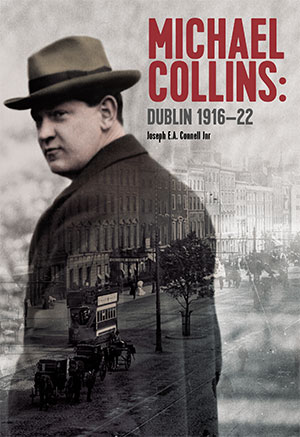Michael Collins: Dublin 1916–22
Published in Book Reviews, Book Reviews, Issue 6 (November/December 2017), Reviews, Volume 25JOSEPH E.A. CONNELL Jr
Wordwell Books
€19
ISBN 9780993351884
Reviewed by Lorcan Collins
Lorcan Collins is the author of 1916: the Rising handbook (O’Brien Press, 2016).

Joe Connell, a regular contributor to History Ireland, is responsible for collecting and publishing an enormous database of addresses associated with the revolutionary period 1916–23. His encyclopaedic knowledge and constant research reap little financial reward, but his legacy is that his books will be read and used by future generations. His latest work specifically concentrates on Michael Collins and the time he spent in Dublin from 1916 to 1922.
Collins had a myriad of ‘offices’ and ‘safehouses’ in Dublin. What is remarkable is how they remain hidden to the general public, as innocuous today as Collins hoped they were a century ago. Connell lists relevant addresses in chapters divided up rather neatly by Dublin’s postal districts. In Dublin 2 we encounter no. 10 Exchequer Street, which Connell calls ‘the first real office’ of the Irish National Aid and Volunteers’Dependants’ Fund. This was also Collins’s ‘first office’, as he became secretary of the fund from February 1917. Alongside the fact that Collins was IRB Centre, Connell notes that these jobs
‘… gave him access to the people who were central within the complex network of parish committees throughout the country. He also had access to information and, as information represented power, he was now at the centre of intelligence regarding the fast-changing political arena in Ireland.’
In Dublin 7 we have a very fine factual account, packed with vignettes, on the IRA’s audacious attack on the British Army at Monk’s Bakery, 79–80 Church Street:
‘Kevin Barry was captured here after an ambush on 20 September 1920 in which three British soldiers were killed. He stopped to reload his .38 calibre Luger (which the IRA always referred to as a “Parabellum”) and hid under a lorry. When it was about to be driven off, a bystander, Margaret Byrne, innocently shouted, “There’s a man under the lorry”, and Barry was arrested. (Tragically, Byrne was killed in 1959 near the same spot on Church Street by a lorry sliding on the street in the rain.)’
Kevin Barry was the first member of the IRA to be executed during the 1919–21 guerrilla war. Connell includes some information on the plans to rescue him from Mountjoy Jail. Thereare conflicting stories about this and Connell’s book demonstrates them. While Oscar Traynor’s Witness Statement (BMH W/S 340) indicates that Barry’s mother was concerned about the rescue attempt because of possible loss of life and believed that he would be released anyway because of his youth, that is at odds with the recollections of Barry’s sister Katherine, who says in her Witness Statement (BMH W/S731): ‘I mention this because of our family’s non co-operation in rescue attempts for the alleged reason that up to the last we were hoping for a reprieve’. Katherine Barry recalled that the IRA had formulated a plan to liberate her brother two days before his execution. Barry’s sisters were to be ‘on the inside’, but the unexpected arrival of a visiting priest, a friend of Barry’s, who was brought to see him first, ruined the timing of the attack, which centred around the changing of the guards. The rescue plan was reluctantly called off by Captain Charlie Byrne. GHQ and Barry’s comrades decided on a desperate plan the following day that involved using a mine to blow a hole in the wall of Mountjoy Jail and rushing the armed British guards. Unfortunately a constant stream of people poured down to the vicinity of the prison to pray for Barry, and despite whispered words to send them away the crowds grew and the attempt to free Barry was called off, as according to Lieutenant Seán O’Neill of Barry’s H Company ‘the slaughter would be awful’ (BMH W/S 1154).
In addition to the vast quantity of addresses associated with Collins, the book includes a number of very useful appendices, such as the thoroughly researched piece on the assassination of Henry Wilson for which two members of the London IRA, Reggie Dunne and Joe O’Sullivan, were hanged in August 1922. Connell adds much to the debate, in a concise fashion, as to where the order to shoot Wilson originated.
Connell’s analysis of the death of Collins at BéalnamBláth will be a useful reference for anyone looking to brush up on the time-line of events associated with the ambush. There are some fine nuggets of information. Few people are aware that part of Collins’sfateful visit to Cork included the commander-in-chief’s visiting some banksin pursuit of £120,000 of Anti-Treaty IRA funds. Collins told the bank managers in no uncertain terms that they would not be allowed to operate unless they fully co-operated with forensic investigators. It’s worth comparing this story to the fate of Alan Bell, who was assassinated by Collins’s Squad on 27 March 1920 for investigating IRA funds held in bank accounts!
Connell, a lawyer based in Florida, has dedicated his spare time to collating information about early twentieth-century Irish revolutionaries, and this book, like his other works,is an invaluable addition to the bookshelves of students, journalists, teachers and anyone interested in Irish history.
















